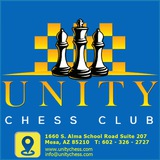Black can try to blockade with 2 … Bd4 and 3 … Bb6. But White breaks it with 3 Ba5 and 4 b6 or 3 Ke2 and 4 Be3.
Unity Chess Club
Fischer – Reshevsky Los Angeles 1961 White to playhould With no passed or queenside pawns White’s chances seem slim. Did he draw after 1.Be4?
He could have won with 1 Rc7+! and 1 …Rf7 2 Rxf7+ Kxf7 3 Bb5! and the knight is dominated.
If 3 … Ke7 4 Kg4 Nd7, White converts to a won pawn endgame 5 Bxd7 Kxd7 6 Kh5.
Unity Chess Club
Bareev – Azmaiparashvilli Shenyang 2000 Black to play Black has more than one way to win. Which is the easiest?
The conversion 1 … Rxe4+! 2 Rxe4 Kxf6. White’s king is cut off.
He tried 3 a4 with the idea of a4-a5 and Kc4-c5-c6. But Black replied 3 … a5 4 Kc5 (4.Kb5 Rd5+! and then Rf5-+) 4...Re7!
Unity Chess Club
Timman – Spassky Hilversum 1983 Black to play White threatens to win the knight with 1 Qe7+ Kc8 2 Qe8+ or 1 f7. What can Black do?
Black created a fortress with 1 … Nxf6! and 2 Qxf6+ Kd7.
The g-pawn isn’t needed to draw. White won it after 3 Qf7+ Kc6 4 Qb3 Re5 4 Kxg4 Kd7.
There is no zugzwang because Black can shift his rook back and forth between c5 and e5. White’s king cannot cross the fifth rank. His queen cannot create a passed pawn or give itself up favorably for the rook.
Unity Chess Club
Grischuk – J. Polgar Biel 2007 Black to play A knight and two connected pawns usually beat a knight. Why is this position different?
It’s different because of a blockade, 1 … Ng4!, and stalemate (2 Nxg4). White gave up one pawn but Black stopped the other, e.g.
2 Nc4 Nh2+ 3 Ke4 Nf1! 4 Ne3 Nxg3+ 5 Ke5 and now 5 … h5 is one way to draw.
Unity Chess Club
Ljubojevic – Smeets Amsterdam 2007 White to play White is in check and will lose the c5-pawn. What’s the difference between 1.Ke5 and 1.Kc7?
White can achieve the checking distance with 1 Kc7! Kxc5 2 Rb1!.
It doesn’t help Black to cut off the king by a rank with 2 …Rh7+ 3 Kc8 since the Black king can’t advance the pawn alone, 3 … Kd5 4 Rd1+! Ke4 5 Rc1 draws
